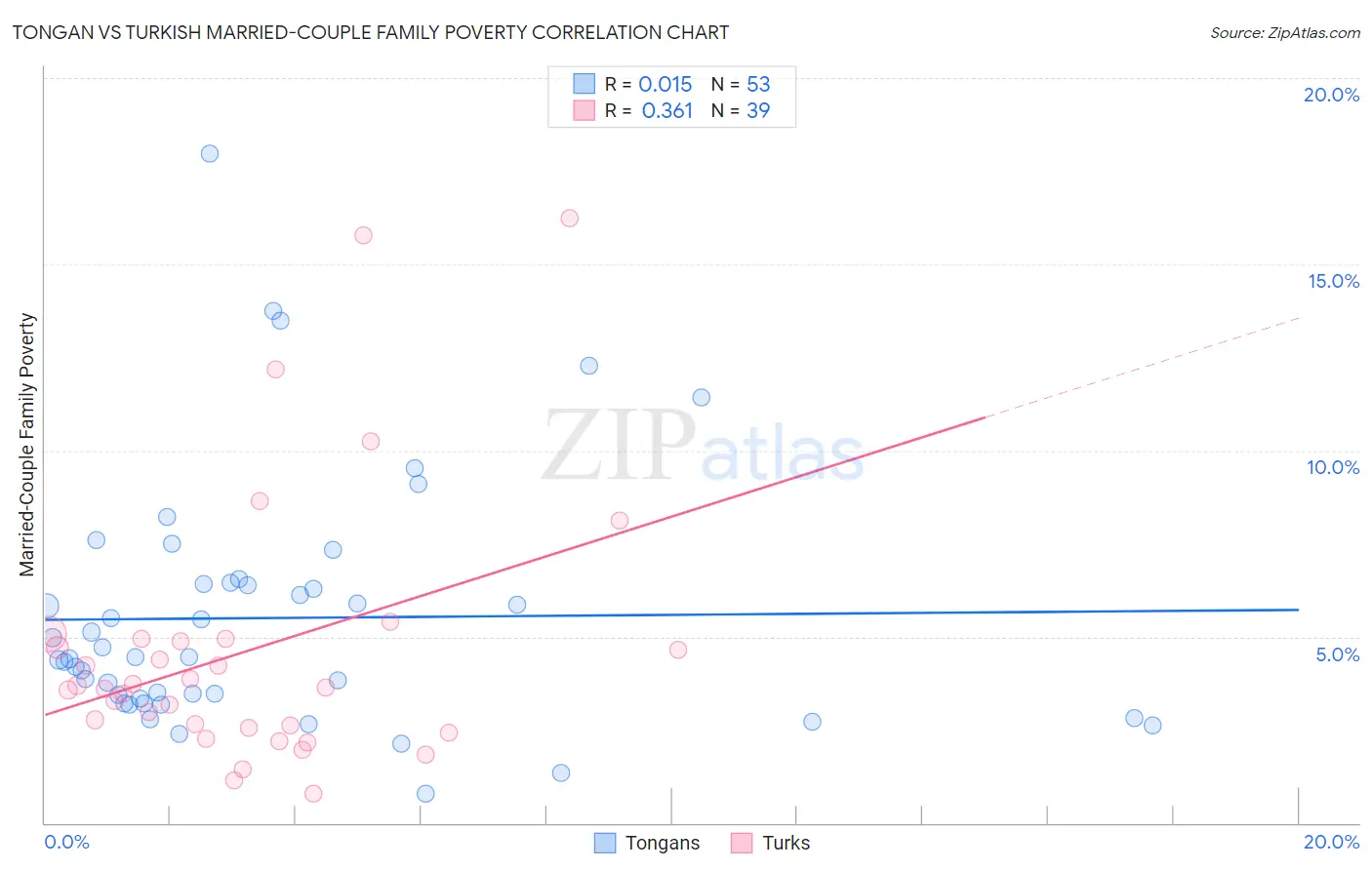Tongan vs Turkish Married-Couple Family Poverty
COMPARE
Tongan
Turkish
Married-Couple Family Poverty
Married-Couple Family Poverty Comparison
Tongans
Turks
4.7%
MARRIED-COUPLE FAMILY POVERTY
95.9/ 100
METRIC RATING
112th/ 347
METRIC RANK
4.3%
MARRIED-COUPLE FAMILY POVERTY
99.7/ 100
METRIC RATING
49th/ 347
METRIC RANK
Tongan vs Turkish Married-Couple Family Poverty Correlation Chart
The statistical analysis conducted on geographies consisting of 102,697,029 people shows no correlation between the proportion of Tongans and poverty level among married-couple families in the United States with a correlation coefficient (R) of 0.015 and weighted average of 4.7%. Similarly, the statistical analysis conducted on geographies consisting of 270,078,353 people shows a mild positive correlation between the proportion of Turks and poverty level among married-couple families in the United States with a correlation coefficient (R) of 0.361 and weighted average of 4.3%, a difference of 9.8%.

Married-Couple Family Poverty Correlation Summary
| Measurement | Tongan | Turkish |
| Minimum | 0.80% | 0.78% |
| Maximum | 18.0% | 16.2% |
| Range | 17.2% | 15.5% |
| Mean | 5.5% | 4.6% |
| Median | 4.4% | 3.6% |
| Interquartile 25% (IQ1) | 3.3% | 2.6% |
| Interquartile 75% (IQ3) | 6.4% | 4.9% |
| Interquartile Range (IQR) | 3.2% | 2.4% |
| Standard Deviation (Sample) | 3.3% | 3.6% |
| Standard Deviation (Population) | 3.3% | 3.5% |
Similar Demographics by Married-Couple Family Poverty
Demographics Similar to Tongans by Married-Couple Family Poverty
In terms of married-couple family poverty, the demographic groups most similar to Tongans are Immigrants from Nepal (4.7%, a difference of 0.070%), Pakistani (4.7%, a difference of 0.18%), Immigrants from Bolivia (4.7%, a difference of 0.22%), Immigrants from Hong Kong (4.7%, a difference of 0.38%), and Laotian (4.7%, a difference of 0.58%).
| Demographics | Rating | Rank | Married-Couple Family Poverty |
| Aleuts | 97.0 /100 | #105 | Exceptional 4.7% |
| Immigrants | France | 96.9 /100 | #106 | Exceptional 4.7% |
| Immigrants | Germany | 96.8 /100 | #107 | Exceptional 4.7% |
| Laotians | 96.6 /100 | #108 | Exceptional 4.7% |
| Immigrants | Hong Kong | 96.4 /100 | #109 | Exceptional 4.7% |
| Immigrants | Bolivia | 96.2 /100 | #110 | Exceptional 4.7% |
| Pakistanis | 96.2 /100 | #111 | Exceptional 4.7% |
| Tongans | 95.9 /100 | #112 | Exceptional 4.7% |
| Immigrants | Nepal | 95.9 /100 | #113 | Exceptional 4.7% |
| Immigrants | Indonesia | 95.1 /100 | #114 | Exceptional 4.8% |
| Taiwanese | 94.8 /100 | #115 | Exceptional 4.8% |
| Celtics | 94.8 /100 | #116 | Exceptional 4.8% |
| Kenyans | 94.7 /100 | #117 | Exceptional 4.8% |
| Immigrants | Philippines | 94.6 /100 | #118 | Exceptional 4.8% |
| Immigrants | Eastern Asia | 94.0 /100 | #119 | Exceptional 4.8% |
Demographics Similar to Turks by Married-Couple Family Poverty
In terms of married-couple family poverty, the demographic groups most similar to Turks are Australian (4.3%, a difference of 0.080%), Burmese (4.3%, a difference of 0.10%), Immigrants from Lithuania (4.3%, a difference of 0.11%), Russian (4.3%, a difference of 0.13%), and Immigrants from South Central Asia (4.3%, a difference of 0.15%).
| Demographics | Rating | Rank | Married-Couple Family Poverty |
| Scottish | 99.8 /100 | #42 | Exceptional 4.3% |
| Swiss | 99.8 /100 | #43 | Exceptional 4.3% |
| Immigrants | Japan | 99.8 /100 | #44 | Exceptional 4.3% |
| Serbians | 99.8 /100 | #45 | Exceptional 4.3% |
| British | 99.8 /100 | #46 | Exceptional 4.3% |
| Immigrants | South Central Asia | 99.8 /100 | #47 | Exceptional 4.3% |
| Australians | 99.7 /100 | #48 | Exceptional 4.3% |
| Turks | 99.7 /100 | #49 | Exceptional 4.3% |
| Burmese | 99.7 /100 | #50 | Exceptional 4.3% |
| Immigrants | Lithuania | 99.7 /100 | #51 | Exceptional 4.3% |
| Russians | 99.7 /100 | #52 | Exceptional 4.3% |
| Welsh | 99.7 /100 | #53 | Exceptional 4.3% |
| Austrians | 99.7 /100 | #54 | Exceptional 4.3% |
| French | 99.7 /100 | #55 | Exceptional 4.3% |
| Immigrants | Zimbabwe | 99.7 /100 | #56 | Exceptional 4.3% |